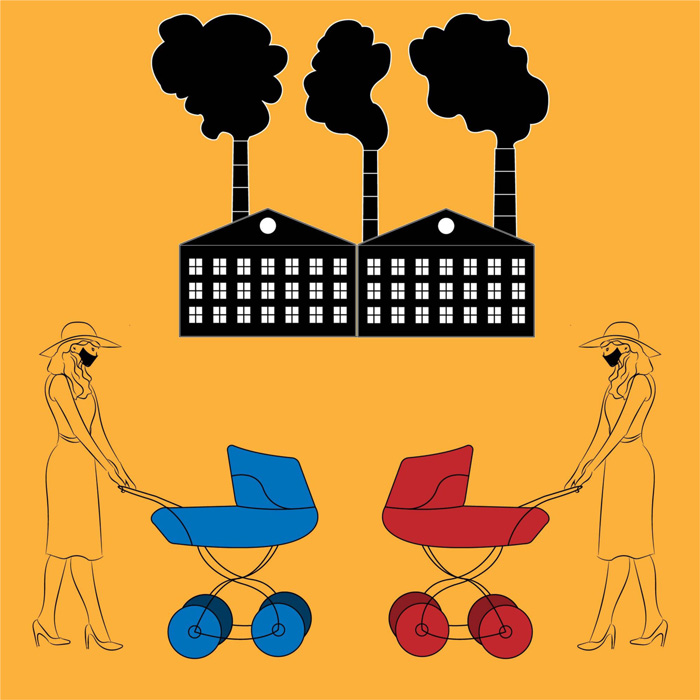By Marcia G. Yerman
Moms Clean Air Force
Back in 2012, I wrote about the Cross-State Air Pollution Rule (CSAPR) and the impacts of pollution that traveled via wind from one state to another. It was a look at the effects of dirty air from “upwind” states on “downwind” states.
Now, 5 years later, a study released December 2017 by Muzhe Yang (Associate Professor in the Economics Department) and Shin-yi Chou (Professor of Economics) of Lehigh University has proven the validity of the “cross-state” air pollution premise. They have authored the paper, The Impact of Environmental Regulation on Fetal Health: Evidence from the Shutdown of a Coal-Fired Power Plant Located Upwind of New Jersey.
Ozone pollution, or smog, is carried by the wind. While this pollution has decreased over time, in part thanks to mandates to reduce dangerous emissions. But climate change exacerbates air pollution, as heat makes ozone pollution and smog worse. Increased heat waves that are expected to come with climate change could mean ozone pollution won’t fall as fast as it would under normal conditions.
Ozone pollution, or smog, is carried by the wind. While this pollution has decreased over time, in part thanks to mandates to reduce dangerous emissions. But climate change exasperates air pollution, as heat makes ozone pollution and smog worse. Increased heat waves that are expected to come with climate change could mean ozone pollution won’t fall as fast as it would under normal conditions.
The analysis of this study examines a specific coal-fired power plant situated on the state borderline between Pennsylvania and New Jersey.
The facility in question was the Portland Generating Station, which was on the Pennsylvania side of the Delaware River. Its shut down in 2014 had a major ramification for the downwind residents of New Jersey. Data revealed a 15 percent reduction in the numbers of low birth weight babies, and a decrease in the occurrence of preterm births by 28 percent.
The results emphasized potential accomplishments when the power of federal law, under the Clean Air Act, supersedes state regulatory directives.
The ruling from the EPA categorized the installation as “a sole pollution source” harming the air quality of New Jersey. The state counties included Warren, Sussex, Morris, and Hunterdon.
The research drilled down on a look at the pollution coming from plant eighteen months prior to its termination. It showed sulfur dioxide emissions at 2,596.648 tons monthly. In the same time span (eighteen months) after the closing, the emissions measured almost zero.
The information was collected from zip codes covering downwind areas within sixty miles of the plant.
Earlier in 2017, a related report by Yang and Chou, with two other writers, showed that infants born during 1990-2006 had a 6.5 percent greater risk of low birth weight and a 17.12 percent greater risk of a very low birth rate (less than 5.50 pounds). This applied to mothers residing within a twenty to thirty-mile radius.
To get an idea about the extent of the pollution that the Portland Generating Station was emitting — in 2006 it ranked number five in the nation for sulfur dioxide emissions. In 2009, the New Jersey Department of Environmental Protection released figures showing that the plant had spewed out a total of 30,465 tons of sulfur dioxide – which equaled over two times the annual sulfur dioxide emissions from all the “electricity-generating facilities in New Jersey combined.”
The creators of the reports believe that the EPA should be more proactive in taking individual states to task when their actions affect the health and well-being of their neighbors.
They also noted that when studies have been done to gauge the connection between public health and the Cross-State Air Pollution Rules, fetal health concerns have been overlooked. In light of the fact that there has been ongoing evidence to show that fetal health is a benchmark for outcomes in later life — from physical health to education and earnings — it seems like an obvious oversight.
And a refresher for those who don’t remember the actions of current EPA head, Scott Pruitt, back in 2011 when he was the Attorney General of Oklahoma…he sued the EPA over the Cross-State Air Pollution Rule.
The impacts of emissions from coal-fired power plants directly affect the fetal health of our babies. Please take a look at this WIND MAP and you can see how the children in your state share the air with other states.



